BUMingham

The Museum of the Jewelry Quarter has been on our list of things to do whilst around Birmingham for some time and finally today we walked down the first couple of locks of the Farmers Bridge flight then headed off northwards. Gradually the buildings turned from light industry and flats to small Victorian factories and then to houses. The houses are mostly shops, jewellers, bullion dealers, we’d entered the Jewelry Quarter.

Here is where the FA cup was designed, whistles for the Titanic were made amongst many other things boasted about on brass plaques laid into the brickwork below your feet as you walk along.
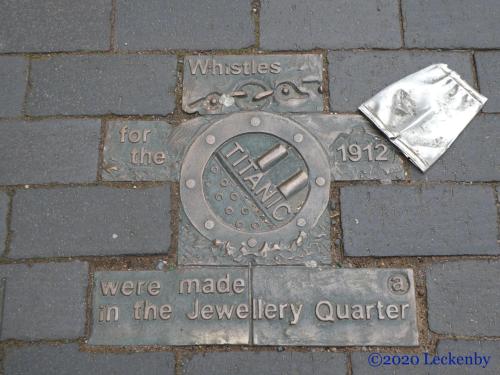
The Chamberlain Clock stands proud as a roundabout, erected in 1903 to commemorate Joseph Chamberlain’s tour of South Africa in 1902/03 after the end of the Second Boer War.

A small group of people were stood taking photos by the bridge over the railway, a Council street cleaner was busy too. It took a couple of seconds to realise why. This is where about two weeks before last Christmas some graffiti appeared overnight right next to benches where the homeless tend to sleep. Banksy had been at work. (Link to footage from Banksy’s Instagram page). The artwork made it into a lot of the papers.

The two reindeer are now covered with sheets of perspex which un-skilled graffiti artists now leave their marks on most days. The council chap was busy removing the latest offering as he chatted away to us, I think he rather enjoys his job now. As the pink squiggles were wiped away we chatted about similar artworks in Birmingham, especially David Bowie by the Bull Ring.

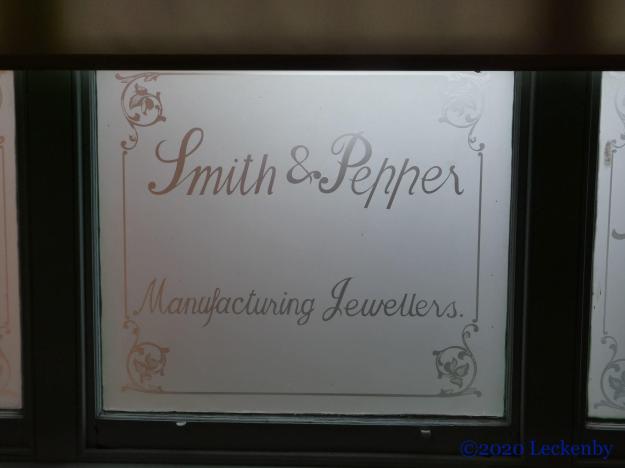
The museum wasn’t too far away and we managed to get onto the next tour round the factory. Smith and Peppers was established in 1899 by Charles Smith and Edwin Pepper (his Uncle) at 77-78 Vyse Street, Charles and his wife lived at 77. By 1914 the business was doing well and they expanded, houses were demolished and a factory built at the back.

In the twenties Eric and Olive Smith (son and daughter of Charles) both joined the company and by the time Charles retired in the 30’s another of his sons, Tom, had joined. Eric and Tom then ran the business with Olive as company secretary. The factory continued until the 70’s when the recession hit them. People had little if any money spare so luxuries like jewelry.


In 1981, Eric, Olive and Tom were 81, 78 and 74 they decided to retire. With no heirs between them they tried to sell the company, but there were no takers. So after the factory summer holidays the staff were gathered on the Monday morning and told to finish off what work they were busy with and at the end of Friday the doors would be closed for the final time.

They tried to get Avoncroft Museum interested but they weren’t. So on that Friday afternoon when the last pieces were finished the workers downed tools and left for the last time, the doors closed behind them everything left just as they left it.
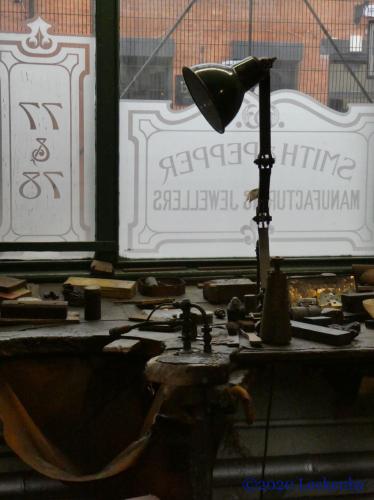
It took quite some time before the Council (who owned the building) to realise what they had and what they could do with it. In the 1990’s someone came up with the idea to open it as a museum. Detailed photographs were taken of everything, the building was emptied so that work could be done to make it safe for the public. Once this was completed everything was returned to the exact position it had been left in in 1981 when the doors closed for the final time. A real snapshot frozen in time.

Today Audrey, a volunteer showed us round. From Eric’s office where orders were taken for wholesale trade, into the main office. Here box files contain every receipt the company ever had. Orders would be recorded and sent down in the dumbwaiter to the factory floor. Eric would have his breakfast, toast with homemade Blackcurrant jam or Marmite. Finished orders would return here by dumbwaiter and be boxed up, reusing packaging, then taken by the young office girl up to the Post Office in a string bag. The Jewelry Quarter was a safe place then, everyone was carrying high value goods about the place. The Post Office here was the busiest in the country outside London.

Down below in the factory we were shown where the days gold was weighed into tin boxes for each worker, at the end of the day these would be returned and weighed, finished items accounted for and a 2% loss was allowed. Each day the floors were hoovered, each day the overalls were washed out, each day all the waste and water was drained through tanks of sawdust, the feet of the wooden stools would be cut back every now and then and below in the cellar this would all be burnt to recoup any gold. Over a period of two years this would amount to quite a chunk of gold.
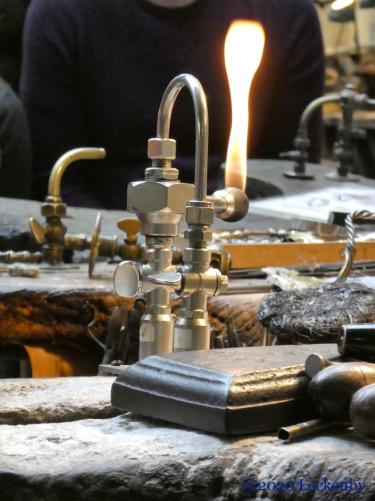
We were shown round where engraving happened, walls covered in iron dyes for stamping out patterns into sheet gold.

A bench where nine jewellers sat soldering bracelets together had an army of angle poises illuminating the benches where soldering flames burnt at the ready, tools looped over string for easy access and leather pinnies fixed to the benches to catch any gold before it reached the floor.

3D relief shapes were stamped into sheets of gold. One chap who worked on this was quite elderly and was pulling almost his whole body weight each time he used the machines, so a motor was added to assist him, but being proud of his skill he refused to use the mechanised assistance.

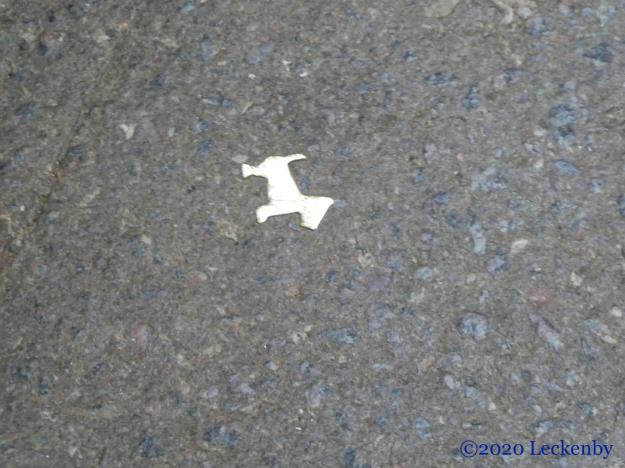
Other hand operated machines cut shapes out of sheet gold. Then a bank of polishing machines would be wurring round constantly with the ladies bringing the shine back to all the pieces.

In a room to one side, tea making facilities sat next to the electroplating. Here the lady would make your tea, whilst handling deadly chemicals and putting items into a cabinet where the fumes would rise out of the factory, a form of health and safety.

What a wonderful place, a must see.
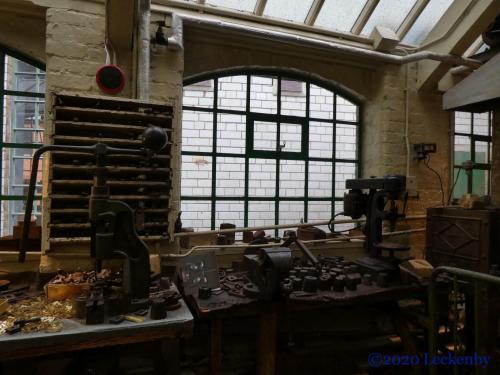
0 locks, 0 miles, 1 cooked breakfast, 2 reindeer, 1 sheet perspex, £7 twice, 2 floors of displays, 1981 stood still, 1 scottie on the floor, 2 adaptors, 1 toaster, 1 dumbwaiter, 3 siblings, 7 shades of overalls, 1 person to befriend, 1 tram, 1 package of post.
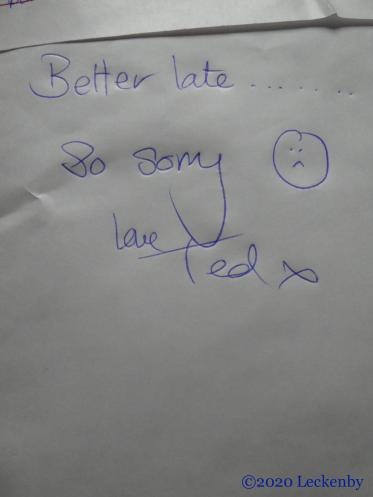

Lovely looking breakfast and a very interesting post. Somewhere I didn’t know existed and a visit from me one day I reckon
Cheers
Well worth a visit Ade. There’s also a coffin and pen museum. Pip
Fantastic story and a fascinating place. Worth a visit one of these days.
You never know what’s there until you look – Birmingham is just 40 miles from us, but we know more about faraway places and London, than we do about Birmingham.
It’s definitely worth a visit Jerry.
We’ve still got the little scottie dog from our visit! Excellent reminder of a fascinating tour, thanks. Was the extractor fan above the cupboard, all eaten away by the fumes, pointed out to you?
Debby
No it wasn’t just how unfitting the doors on it were. The extractor above the door you leave by had certainly seen much better days, the blades reduced in parts to about a third! Pip
Fascinating – we’re planning to go to Brum on this next trip – I hope I can find this!